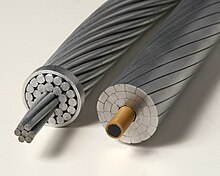ACCC conductor
A major contributor to this article appears to have a close connection with its subject. (February 2024) |
ACCC (Aluminum Conductor Composite Core) is a registered trade mark for a type of "high-temperature low-sag" (HTLS) overhead power line conductor.
Description
[edit]CTC Global (formerly Composite Technology Corporation) used this power line conductor technology. The ACCC patent filed by CTC Global was revoked on July 3, 2019, by the European Patent Office (EPO), after an opposition procedure filed by Epsilon Composite, Mercury Cable & Energy, and Mercury Cable International.[1]
Suspected frauds and legal infringements
[edit]In 2017, the Premium Times published an article about cases of corruption involving CTC Global and Power Transmissions officials, covering ACCC contracts from 2012 up to 2017.[2] In 2018, Jason Huang, CTC’s Former CEO and then Chief Technology Officer from 2010 to 2016, claimed in a California court proceeding that he was wrongfully terminated by CTC because he challenged CTC’s fraudulent representation that its product could perform in a manner CTC had not evidenced it could, which put the public at risk.[3]CTC Global and Jason Huang signed a settlement agreement to close the litigation on June 30, 2020. In 2011, CTC Global was acquired by 2 Russian conglomerates, Kaskol and Ru-Com, which are owned by Russian oligarchs involved in the Russian military complex.[4] The European parliament examined suspected circumvention of sanctions against Russia by CTC Global in 2023.[5]
Advantages
[edit]It is able to carry approximately twice as much current as a traditional aluminium-conductor steel-reinforced cable (ACSR) cable of the same size and weight,[6]

Its light weight and softness result in roughly 30% greater conductivity than an equivalent ACSR conductor, allowing 14% more current to be carried at equal temperature. For example, 1.107 in (28.1 mm) diameter ACCC "Drake" conductor at 75 °C has an AC resistance of 106 mΩ/mile,[7] while equivalent ACSR conductor has an AC resistance of 139 mΩ/mile,[8] 31% higher.

Operation at high temperatures implies high line losses, which may be uneconomical, but the ability to carry such current contributes to the redundancy of the electric grid (the high overload capacity can stop a potential cascading failure) and thus can be valuable even when rarely used directly. Even at higher operating temperatures, the ACCC conductor's added aluminum content and lower electrical resistance offers reduced line losses compared to other conductors of the same diameter and weight.
Disadvantages
[edit]
- The primary disadvantage is cost; ACCC costs 2.5–3 times as much as ACSR cable.[9]: 17
- Although ACCC has significantly less thermal sag than even other HTLS conductor designs,[10]: 20 it has a lower axial stiffness. Therefore, it sags more than other designs under ice load, although an "ultra-low-sag" (higher modulus) version is available at a cost premium.[10]: 21 Also, other aluminium alloys with an increased strength at the expense of electrical conductivity can be used to improve ice load sag. Ice load can also lead to the loosening of outer layer strands because of plastic deformation by the attached weight.
- Annealed aluminum is extremely soft and makes the conductor prone to surface damage during installation if mishandled.
- The conductor has a larger minimum bend radius, requiring extra care during installation.
- The conductor requires special fittings and stringing equipment that are more expensive.
References
[edit]- ^ "EP About this file - European Patent Register". register.epo.org. Retrieved 2024-08-31.
- ^ https://www.premiumtimesng.com/news/headlines/219720-exclusive-buhari-administration-plotting-to-break-nigerian-law-in-award-of-800million-contract.html
- ^ "CTC Global Corporation v. Jason Huang, 8:17-cv-02202 - CourtListener.com". CourtListener. Retrieved 2024-08-31.
- ^ https://www.businesswire.com/news/home/20110818006260/en/CTC-Cable%25E2%2580%2599s-
- ^ MEBAREK, Raphaël GLUCKSMANN, Nora. "Parliamentary question | Suspected circumvention of sanctions against Russia by CTC Global | P-001986/2023 | European Parliament". www.europarl.europa.eu. Retrieved 2024-08-31.
{{cite web}}: CS1 maint: multiple names: authors list (link) - ^ Wareing, B. (28 February 2011). Types and Uses of High Temperature Conductors (PDF). CIGRÉ (International Council on Large Electric Systems) Seminar. Bangkok: CIGRÉ Study Committee B2 Working group 11. Archived from the original (PDF) on 3 December 2013. Retrieved 2014-02-03.
- ^ Banerjee, Koustubh (January 2014). Making the Case for High Temperature Low Sag (HTLS) Overhead Transmission Line Conductors (PDF) (M.Sc.). Arizona State University. p. 70.
- ^ "Aluminum Conductor. Steel Reinforced. Bare". Southwire. Archived from the original on 2016-03-04. Retrieved 2016-01-08.
- ^ Cite error: The named reference
Clairmontwas invoked but never defined (see the help page). - ^ a b Cite error: The named reference
Slegerswas invoked but never defined (see the help page).
